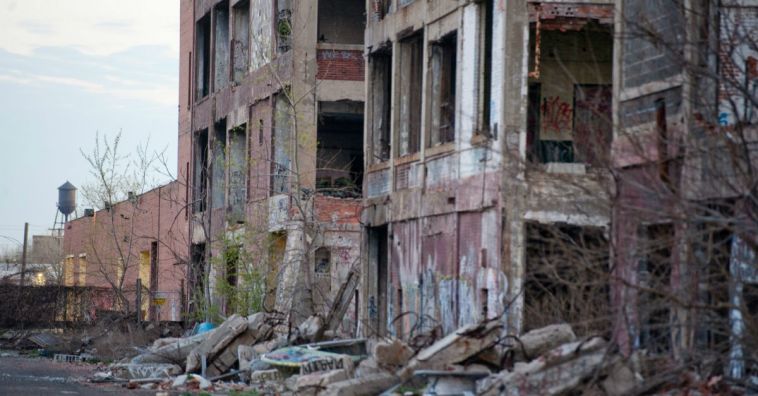Soon-to-be insolvent pensions and near-bankrupt governments are the most obvious consequences of cities and public-sector unions striking fiscally feckless deals. But there are other, less often noted, consequences of this cancerous collusion.
Videos By Rare
Tour the abandoned landmarks of bankrupt Detroit and the nearly-busted Philadelphia and you will see another ugly casualty of cities giving away the whole public purse and then some to the unions. It makes for governments too broke make historic preservation even possible.
In Detroit, some 3,916 arsons were committed between 2008 and 2012, destroying numerous landmarks alongside other abandoned buildings. Among the historic treasures destroyed by fire in that period: the Fisher Body #10 Plant.
The Fisher plant was designed and built by famed industrial architect Albert Kahn, the pioneer of reinforced concrete construction. It went up in flames last February. Numerous efforts to fill the plant with new occupants were unsuccessful before the arson led to its demolition.
Meanwhile 78,000 buildings sit abandoned, falling into disrepair, becoming homes to squatters, and ultimately, becoming vulnerable to arson. These abandoned buildings include Michigan Central Terminal, the 18-story former train station designed by the architects of New York’s Grand Central. It has become a haunt for homeless junkies as well as a favored set piece for adventurous photographers and directors such as Michael Bay.
The nearby Roosevelt Warehouse is another Albert Kahn-designed building. It was abandoned by the city’s failing school district 28 years ago and gained worldwide infamy five years ago. The body of Johnny Redding, a homeless coke addict, was found in a frozen pool of water in one of its elevator shafts, legs and feet sticking up above the ice. Redding’s body was spotted by a photographer checking out an impromptu hockey game played by urban explorers.
There’s also the King Solomon Baptist Church on Motown’s northwest side. It became an epicenter of the civil rights movement in the 1960s when it hosted speeches by Martin Luther King and Malcolm X. While the 97-year-old church has been designated a landmark by the city two years ago, it will likely be slowly gutted of its metal and artwork until a coked-up squatter lights a match.
Meanwhile, Philadelphia’s Center City is littered with abandoned landmarks such as the Beaux Arts-era Hale Building, a former bank building designed by famed architect Willis Hale that now sits boarded up and marked up by graffiti. Elsewhere in the city is another Hale-designed building, the Divine Lorraine Hotel, the nation’s first integrated lodging.
Certainly you can’t preserve every old building in a city and shouldn’t try. As Harvard University economist Edward L. Glaeser has pointed out, landmarks preservation laws that end up preserving undistinguished townhouses alongside truly historic structures such as Grand Central is one reason why cities such as New York have become such a stretch for middle-class residents.
Yet there are former factories, office buildings, apartments, even railroad depots such as Michigan Central which deserve to be preserved, to be revitalized, and reused as hotels, apartments and museums. There are even clusters of buildings that deserve to be revitalized, if possible, because of what they represent to the community.
In thriving cities such as New York City, preservation efforts are the norm, with young urbanites and developers with an eye for historic buildings working both on their own (and with the occasional help of municipal tax credits).
These preservation efforts can only come to fruition if a city has its house in order. This includes having the solid financial footing needed to attend to the quality of life issues – from basic police and fire service to combating vandalism – that are of the greatest concern to the residents, developers, and businesses needed to repurpose old buildings.
But for Detroit, increasingly for Philadelphia, and for many other municipalities throughout the country, the long-term burdens from their deals with public-sector unions make historic preservation almost impossible.
For the past half-century, the Motor City struck generous pension and pay deals with unions such as the American Federation of State County and Municipal Employees – including handing out $1 billion in so-called “13th-check” bonuses to pensioners – even as its population went into free-fall.
By the time it went into bankruptcy, the city’s debts (including officially-reported pension liabilities of $2.1 billion, and $5.7 billion in unfunded retiree healthcare costs) had constrained its ability to equip firefighters with the tools they needed to fight arson.
Add in Detroit’s unenviable status as one of the nation’s most-violent cities – at a time when once-notoriously unsafe New York is now among America’s safest places to live – and it is little wonder why anyone would bother living there.
Philadelphia has fared not much better. The decades of pension deals with public-sector unions have left the City of Brotherly Love with $5 billion in officially-reported (and understated) pension liabilities, according to the city’s 2013 actuarial report. Pension costs will account for 16.5 percent of city spending by 2015-2016, more than double the costs in 2001.
While Philly spent recklessly, it failed to address its quality-of-life issues. The city’s violent crime rate of 1,160.1 per 100,000 in 2012 is nearly double that of New York despite the fact that its population is seven times smaller than the Big Apple.
The biggest obstacle to Philadelphia’s revitalization may be its school district, one of worst-performing in the nation. Thanks to the costs of its own deals with the teachers union and the debts it accumulated from a $1.5 billion spending spree on new buildings, the district teeters on bankruptcy. Last year, it shuttered 23 half-empty schools, saddling the city with more abandoned buildings that may not be preserved or reused.
The lessons from Detroit and Philadelphia are clear for those who want to preserve landmarks. Striking generous deals with public-sector unions is ruinous to balance sheets and the worthy goal of preserving the best of our past.

